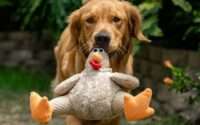When Do Beagles Calm Down? The Ultimate Guide to Beagle Behavior
Welcome to BarkLikeMeow’s in-depth guide on understanding your lively Beagle’s journey to calmness. Beagles are renowned for their spirited personalities, boundless enthusiasm, and undying affection. If you’re a Beagle parent, you’re probably familiar with the whirlwind of energy these little canines bring into your life.
In this comprehensive guide, we’re going to delve deep into the world of Beagles and answer the age-old question: “When do Beagles calm down?” We’ll take you on a fascinating journey through their development, from playful puppies to well-mannered adults.
Beagle owners, both experienced and novice, know that these lovable hounds come with their unique set of traits, quirks, and, of course, endless energy. Understanding their journey to becoming well-behaved companions is vital for ensuring a harmonious life together.
So, fasten your seatbelts and get ready to explore the exciting world of Beagles, as we unveil the secrets to helping your furry friend find their inner calm amidst all the exuberance.
The Beagle Breed: An Overview
The Beagle, often called the “merry little hound,” is a small to medium-sized breed that boasts a rich history. These cheerful and curious canines have been companions to humans for centuries, making them one of the most beloved breeds around.
Originating from England, Beagles were initially bred for hunting small game like rabbits and hares. Their compact size, keen nose, and boundless energy made them excellent hunting partners. Today, they’re more likely to be your family’s hunting partner for lost socks and food scraps!
One of the most striking characteristics of Beagles is their friendly and social nature. They’re known for their affectionate disposition, making them a top choice for families and individuals seeking a loyal and playful companion.
However, it’s not all fun and games. Beagles are notorious for their energy levels, and their zest for life can sometimes feel overwhelming, especially for first-time Beagle owners. It’s important to understand that these lively traits are deeply ingrained in their breed’s DNA.
So, if you’ve ever wondered why your Beagle is bouncing off the walls or how you can help them find their inner Zen, you’re in the right place. In the following sections, we’ll explore the different stages of a Beagle’s life, their journey from puppyhood to adulthood, and when you can expect them to calm down and become your perfect, well-behaved companion. Let’s dive in!
Puppyhood: The Energetic Phase
Ah, puppyhood! It’s the stage of life when your Beagle is at their most energetic, curious, and, let’s face it, mischievous. Beagle puppies are bundles of joy, but they also pack quite a punch in the energy department.
From the moment they open their eyes, Beagle puppies are on a mission to explore the world. Their noses, always alert, are like tiny detectives on a scent adventure. Their boundless enthusiasm knows no bounds, and they’ll happily engage in endless games of chase, tug-of-war, and general puppy chaos.
Socialization and training are of utmost importance during this phase. As Beagles are naturally sociable, it’s a prime opportunity to introduce them to various people, animals, and environments. This helps them grow into well-rounded adults, ready to tackle the world with confidence.
However, don’t be surprised if you encounter some behavioral challenges during Beagle puppyhood. Beagles are known for their stubborn streak and a tendency to follow their noses, often leading them astray. But with patience, consistent training, and lots of love, you can guide them toward good behavior.
Adolescence: Turbulent Teenage Years
The teenage years can be tumultuous for Beagle owners. Just like human adolescents, Beagle teenagers go through a phase where they might test boundaries, challenge rules, and exhibit a certain level of independence.
This phase, often humorously referred to as the “Beagle Hooligan” stage, typically occurs between six months to two years of age. During this time, your Beagle might become even more energetic and inquisitive, which can lead to some interesting and occasionally frustrating experiences.
It’s essential to maintain consistent training and exercise routines during adolescence. Beagles have a reputation for being persistent, and they’ll need clear boundaries and guidance to navigate this transitional phase. Additionally, increased exercise can help channel their energy into positive outlets.
Don’t despair; the teenage years are just a phase, and as your Beagle matures, you’ll see the fruits of your hard work. In the next section, we’ll delve into when you can expect your Beagle to reach adulthood and experience a decrease in hyperactivity. Stay tuned!
Adulthood: The Quest for Calmness
Beagle owners, here’s the moment you’ve been eagerly awaiting: adulthood. But when do Beagles actually reach this stage of relative calm? While individual timelines may vary, Beagles generally enter adulthood between one to two years of age.
As your Beagle transitions into adulthood, you’ll start to notice a gradual decrease in hyperactivity. Their youthful exuberance gives way to a more composed demeanor. This is the time when many Beagle parents breathe a sigh of relief as they see their furry friend transforming into a well-behaved companion.
Keep in mind that the exact timing of this transition depends on various factors, including genetics and individual development. Nevertheless, with consistent training, patience, and love, your Beagle can become a charming and well-mannered adult.
Factors Affecting Beagle Energy Levels
Beagle energy levels are a complex interplay of genetics, diet, exercise, and individual personality. Let’s break down these factors to better understand how they impact your Beagle’s vitality.
- Genetics: Beagle energy is deeply rooted in their genes. Some Beagles may inherit a more relaxed disposition, while others are born with an inexhaustible zest for life. Understanding your Beagle’s genetic predisposition can help you tailor your approach to their specific needs.
- Diet and Nutrition: Proper nutrition plays a pivotal role in your Beagle’s overall health and energy levels. Feeding your Beagle a well-balanced diet with the right nutrients is essential for maintaining their vitality.
- Exercise and Activity: Beagles require regular physical activity to burn off their abundant energy. If they don’t get enough exercise, they may resort to less desirable outlets for their energy, such as destructive behaviors or excessive barking.
- Mental Stimulation: In addition to physical exercise, Beagles thrive on mental stimulation. Puzzle toys, interactive games, and training sessions can help challenge their sharp minds and keep them engaged.
- Environmental Enrichment: A stimulating environment with opportunities for exploration and play can contribute to your Beagle’s overall well-being. Consider creating a dog-friendly space where they can expend their energy.
In the following sections, we’ll delve deeper into the role of exercise, training, and mental stimulation, providing you with practical tips and strategies to help your Beagle stay happy and content. Remember, a combination of factors, carefully balanced, can lead to a well-adjusted and calmer Beagle. Stay with us to discover the keys to a harmonious life with your energetic companion.
Exercise and Activity for Beagles
Beagle owners, rejoice! Regular exercise is your secret weapon in managing your Beagle’s boundless energy. These spirited pups benefit immensely from physical activity, and providing them with ample opportunities to burn off their energy can lead to a happier and calmer furry friend.
So, what kinds of activities can help your Beagle stay physically and mentally engaged? Here are a few tips:
- Daily Walks: Beagles love going for walks, and they have a natural instinct to follow scents. Take them on daily walks to allow them to explore and satisfy their curiosity.
- Interactive Play: Engage in games like fetch, tug-of-war, and hide-and-seek. These activities stimulate both their body and mind.
- Dog Parks: Visiting a dog park is an excellent way for your Beagle to socialize and enjoy off-leash play with other dogs.
- Scent Work: Tap into their natural hunting instincts with scent games. Hide treats or toys for them to find, which is a mentally stimulating activity.
- Hiking and Exploration: Take your Beagle on hiking trips or nature walks to allow them to experience new scents and sights.
The key is to keep your Beagle active and engaged to prevent boredom, which can lead to destructive behavior. With a consistent exercise routine, you can help your Beagle maintain a healthy balance between playfulness and calmness.
Training and Socialization
Training and socialization are vital components of raising a well-behaved Beagle. Beagles are known for their intelligence, but they can also be a bit stubborn. Training and socialization from a young age can help shape their behavior and ensure they become delightful companions.
Here are some training and socialization tips for your Beagle:
- Basic Obedience: Start with basic obedience commands like sit, stay, and come. These commands are not only essential for your Beagle’s safety but also for a harmonious life together.
- Positive Reinforcement: Beagles respond well to positive reinforcement. Use treats and praise to reward good behavior.
- Consistency: Beagles thrive on routine and consistency. Establish clear rules and stick to them, so your Beagle knows what’s expected.
- Socialization: Expose your Beagle to various people, animals, and environments. This will help them develop into well-adjusted adults with good social skills.
- Professional Training: Consider enrolling in a puppy training class or seeking the help of a professional dog trainer if you encounter specific behavior challenges.
Training and socialization require time and patience, but they are key to helping your Beagle become a polite and well-mannered member of your family. Stay committed to these efforts, and you’ll reap the rewards as your Beagle matures into a loving and well-behaved companion.
Coping with Behavioral Challenges
Beagles, like all dogs, may face certain behavioral challenges along their journey to adulthood. These challenges can range from separation anxiety to excessive barking and everything in between. As Beagle parents, it’s important to address these challenges with care and patience.
Let’s explore some common behavioral problems and their solutions:
- Separation Anxiety: Beagles are known for their attachment to their humans, which can sometimes lead to separation anxiety. Gradual desensitization, crate training, and providing interactive toys can help ease this anxiety.
- Excessive Barking: Beagles have a strong voice, and they’re not afraid to use it. Training your Beagle to bark on command and rewarding quiet behavior can help manage excessive barking.
- Chewing and Destructive Behavior: Beagle puppies, in particular, love to chew. Providing appropriate chew toys and dog-proofing your home can help prevent destructive chewing.
- Digging: Beagles have a natural instinct to dig. Creating a designated digging area or using deterrents can help minimize this behavior.
If you’re facing behavioral challenges with your Beagle that you can’t address on your own, don’t hesitate to seek professional help from a dog trainer or behaviorist. They can provide tailored guidance to help you and your Beagle overcome these challenges and enjoy a more harmonious relationship.
The Role of Mental Stimulation
Mental stimulation is a crucial aspect of keeping your Beagle happy and well-behaved. Beagles are intelligent dogs, and without proper mental exercise, they can become bored and resort to undesirable behaviors.
Here’s how you can provide mental stimulation for your Beagle:
- Puzzle Toys: Invest in puzzle toys that challenge your Beagle’s problem-solving skills. These toys often dispense treats as rewards, making them even more engaging.
- Training Sessions: Regular training sessions not only reinforce obedience but also stimulate your Beagle’s mind. Teach new tricks or revisit old ones to keep their minds sharp.
- Hide and Seek: Hide treats or toys around the house and encourage your Beagle to find them. This taps into their natural hunting instincts.
- Interactive Games: Games like “find the hidden toy” or “shell game” are excellent ways to engage your Beagle’s mind.
- Change of Scenery: Take your Beagle on new routes during walks or visit different parks to expose them to novel sights and smells.
Remember that mental stimulation is as important as physical exercise. It can prevent boredom and destructive behavior, and it’s an excellent way to bond with your Beagle. By keeping their minds active, you’ll help them on their journey to becoming a calmer and content canine companion.
Maintaining a Beagle’s Health
Keeping your Beagle healthy is an integral part of managing their energy levels and ensuring they grow into a well-behaved adult. Regular vet visits, proper nutrition, and preventative care are key components of maintaining your Beagle’s overall well-being.
Here’s what you need to know about keeping your Beagle in top shape:
- Regular Vet Visits: Schedule routine check-ups with your veterinarian to monitor your Beagle’s health, address any concerns, and ensure they receive vaccinations and preventive treatments as needed.
- Nutrition: Provide a balanced diet with high-quality dog food. Beagles can be prone to obesity, so be mindful of portion sizes and treats. Consult your vet for dietary recommendations.
- Exercise and Weight Management: Maintaining a healthy weight through proper exercise and diet is crucial for your Beagle’s long-term health.
- Preventative Care: Stay up-to-date with vaccinations, flea and tick prevention, and heartworm medication to keep your Beagle protected against common health threats.
- Dental Care: Beagle owners often overlook dental health. Regular teeth cleaning and dental chews can help prevent dental issues.
A healthy Beagle is a happy Beagle, and their energy levels are closely tied to their overall health. By prioritizing their well-being, you’ll be better equipped to navigate their energetic phases and help them on their journey to becoming a well-behaved companion.
Beagle Stories: Real-Life Experiences
It’s always heartwarming and enlightening to hear real-life stories from Beagle owners who have experienced the joy and challenges of raising these spirited pups. Let’s dive into some Beagle tales that showcase the journey from puppyhood to a calmer and well-behaved Beagle:
The Mischievous Pup: Meet Max, a Beagle with endless energy. His owner, Sarah, shares how they navigated the puppy stage, including the inevitable shoe-chewing incidents, with consistent training and plenty of exercise. Max is now a well-behaved adult Beagle and a beloved family member.
From Barky to Balanced: Lucy, another Beagle, had a tendency to bark excessively. Her owner, Mark, tells the story of their journey to managing her exuberance through positive reinforcement and training. Today, Lucy enjoys peaceful evenings at home.
The Socialite Beagle: Sophie, a social butterfly of a Beagle, had a habit of jumping on everyone she met. With dedicated socialization and training, Sophie’s owner, Emily, shares how they transformed her into a polite and friendly adult Beagle who greets guests with a wagging tail instead.
These real-life experiences from Beagle owners highlight the rewards and challenges of raising these spirited dogs. Their stories offer inspiration and insight for anyone embarking on the adventure of Beagle ownership. Remember, with patience, training, and love, your Beagle can also become a well-mannered and cherished companion.
Conclusion
Congratulations, Beagle enthusiasts, on completing our journey through the world of Beagle energy levels and the quest for calmness. We’ve explored the vibrant personality of Beagles, from their energetic puppyhood to the more composed adulthood, with all the thrills and challenges in between.
The key takeaway from this comprehensive guide is that Beagles are delightful companions who, with proper care and training, can thrive and grow into well-behaved adults. Each Beagle’s journey is unique, and the path to calmness is a rewarding one.
Embrace the quirks, appreciate the energy, and cherish the love your Beagle brings to your life. By understanding their needs, staying patient, and providing consistent training and care, you’ll pave the way for a harmonious life with your beloved Beagle.
Frequently Asked Questions
When do Beagles calm down?
Beagles typically start to calm down and mature into well-behaved adults between one and two years of age. However, individual timelines can vary.
How much exercise does a Beagle need?
Beagles require at least 1-2 hours of exercise daily. Regular walks, playtime, and mental stimulation are essential to keep them happy and healthy.
Are Beagles good with children and other pets?
Beagles are generally good with children and other pets, but early socialization is crucial to ensure a positive relationship with other family members and furry friends.
How can I manage Beagle barking?
Training and positive reinforcement can help manage Beagle barking. Teaching the “quiet” command and addressing the root cause of the barking are effective approaches.
What is the best way to house train a Beagle puppy?
Consistent and positive reinforcement-based house training is key. Take your Beagle puppy outside frequently, reward them for potty success, and establish a routine to minimize accidents.
Do Beagles shed a lot?
Beagles have a short, dense coat that sheds moderately throughout the year. Regular brushing can help manage shedding and keep their coat healthy.
Can Beagles be left alone at home?
Beagles can be left alone, but it’s essential to ensure they have sufficient mental and physical stimulation. Consider crate training and interactive toys to keep them engaged.
How can I prevent my Beagle from digging in the yard?
Provide a designated digging area, use deterrents in areas you want to protect, and ensure your Beagle gets enough exercise to curb their digging instincts.
Is it possible to train a Beagle to be off-leash?
Beagles have a strong prey drive, making off-leash training challenging. While some Beagles can be trained to be off-leash in secure areas, it’s crucial to prioritize safety and use a leash in unfamiliar environments.
What are common health concerns for Beagles?
Beagles can be prone to obesity, hip dysplasia, and ear infections. Regular vet check-ups, a balanced diet, and proper ear care can help manage these concerns.




